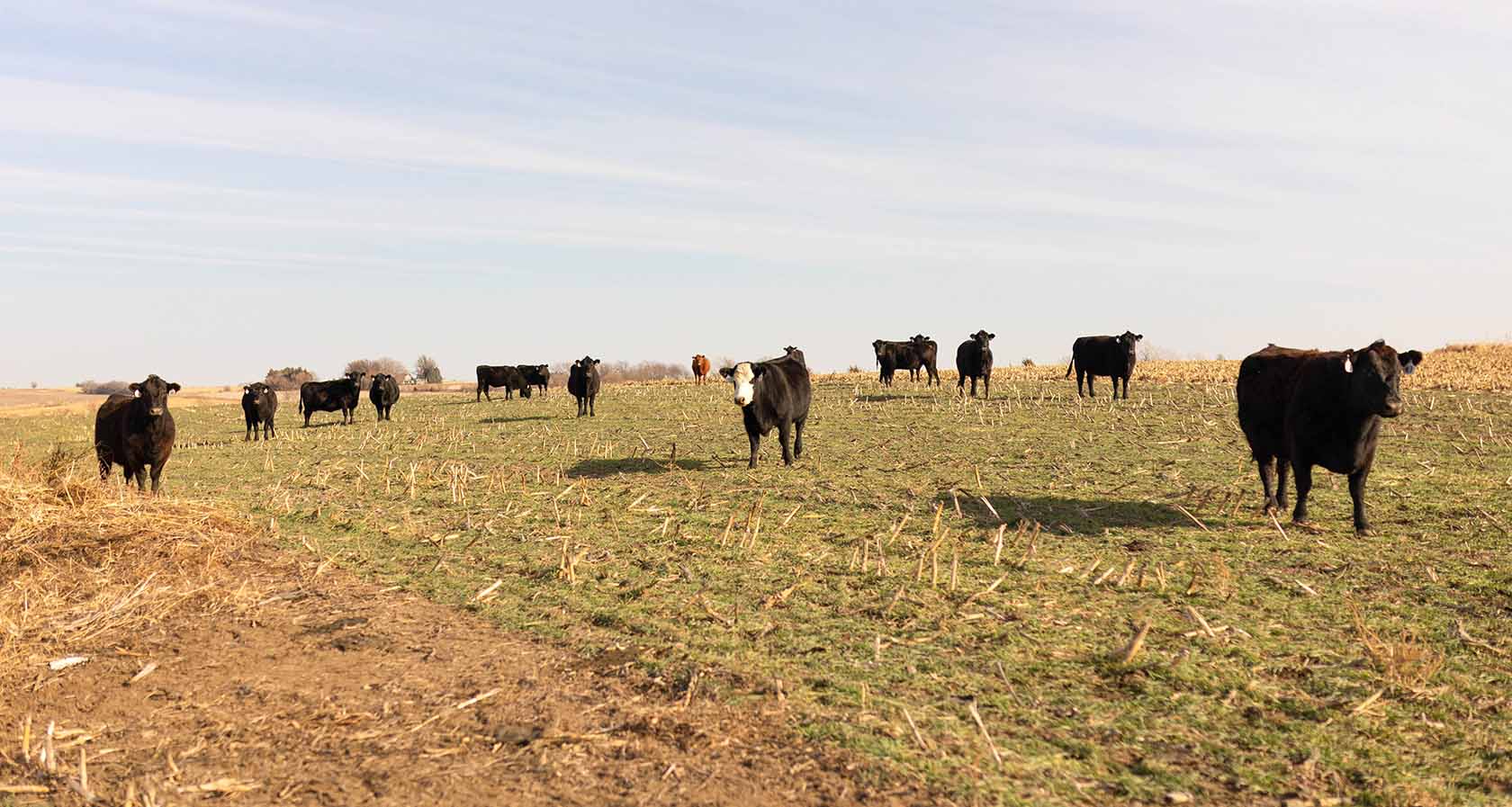
(Photo: Iowa Soybean Association / Joclyn Kuboushek)
Should you graze cover crops?
August 5, 2025 | Brock Webb, CCA
Key takeaways:
- Short-term economic impact when grazing cover crops.
- Early seeding cover crops increases biomass and feed value.
- Regional cost-share opportunities help incentivize livestock grazing cover crops.
An often-overlooked benefit of cover crops is the ability to provide quality grazing for livestock. Grazing cover crops has been shown to be the most economically beneficial way to integrate cover crops into row crop production.
There are several decisions to make when planning for a successful cover crop establishment. Grazing livestock on cover crops can reduce feed and labor costs while promoting soil health. While the soil health benefits may take time to appear, grazing them can provide a more immediate ROI.
Infrastructure for grazing
Adequate fencing and water resources are crucial considerations before implementing cover crops for grazing livestock. If you plan to use temporary fences, you must determine the height and size of fences you'll need. While permanent water sources aren't essential, it can save you time from hauling water to the field.
Optimizing acres
Livestock farmers who graze their animals on corn stalks could maximize their acres by adding cover crops. While grazing soybean acres provides little value, cover crops can improve those acres, especially with proper fencing and water infrastructure. A study conducted by Practical Farmers of Iowa found that farmers who grazed their livestock on cover crop acres realized an average return of $77 per acre. To increase biomass from your cover crops, consider extending the cover crop's growing season by planting shorter maturing soybeans and shorter season corn hybrids.
Nutrient value
When selecting species for grazing, prioritize nutritional value.
Determine if fall or spring grazing will work best for your needs. In some cases, species selection enables both seasons of grazing if livestock do not overgraze the cover crop.
Diverse cover crops will also help meet livestock nutritional needs. For fall and spring grazing, you can mix several species; oats, turnips and tillage radishes are ideal for fall grazing.
For spring and fall grazing early establishment of cereal rye, triticale, wheat and barley can provide great opportunity.
Speaking with your local cover crop seed salesman on seed availability and species selection will help you make this decision. There are many other options for species, and you can tailor this decision based on your goals and needs.
Application strategies
Timing and seeding method are key to maximizing biomass for grazing. For livestock producers, aerial application - by plane or drone - may be the most effective option.
Aerial applications allow for earlier seeding than drilling, which can be an advantage to overall biomass produced. In this case, seeding rates should be increased to ensure better establishment across the field.
Drilling cover crop seed allows for better seed-to-soil contact and overall better stand in the field.
Broadcasting seed into a standing crop with a high clearance ground rig provides a more uniform stand than aerial seeding.
If applying seed to a standing crop, pay attention to the maturity of the crop and future weather conditions. For ideal germination, apply the seed before it rains.
Once soybean leaves start to turn yellow, the cover crop can be broadcast into the canopy. This allows enough sunlight for emergence given there is adequate moisture.
Herbicide considerations
Herbicide selection throughout the year should be reviewed to ensure there is no herbicide carryover that would prevent livestock grazing. To ensure that herbicide carryover is not an issue, read labels carefully and follow rotation restrictions of the products. There has been little research on herbicide carryover affecting cover crops, so it's best to play it safe when in doubt.
Cereal rye is less sensitive to carryover while tillage radish may be more sensitive.
When using a broadleaf herbicide with residual, it is best to select a grass species and when using a grass herbicide focus on broadleaf covers.
Cost-share options
There are many cost-share opportunities for livestock producers who want to add cover crop grazing into their operations. One example is the Water Quality Initiative in Taylor County, where farmers can sign up for $35 per acre for any cover crop acres that are used for grazing. Statewide, Iowa Department of Agriculture Land Stewardship (IDALS) has a cost-share program for new and existing cover crop acres.
When applying for state and federal cost-share programs, check if grazing is allowed on cover crop acres.
The addition of cover crops to a row crop operation can create opportunities for livestock producers without additional land purchases. It can increase the efficiency and profitability of every acre under the right conditions and management.
Do you have land but no livestock? Consider renting your acres to livestock farmers. The Midwest Grazing Exchange can help match producers with cover crop grazing opportunities.
Having a plan is key when implementing new practices. Grazing cover crops are proven to provide short-term economic benefits even without the help of cost-share programs.
Cover Crop Economics Simulator Tool
Dig deeper into the economics of cover crops through ISA's Cover Crop Economics Simulator tool at iasoybeans.com/CoverCropSim.
Written by Brock Webb.
Back